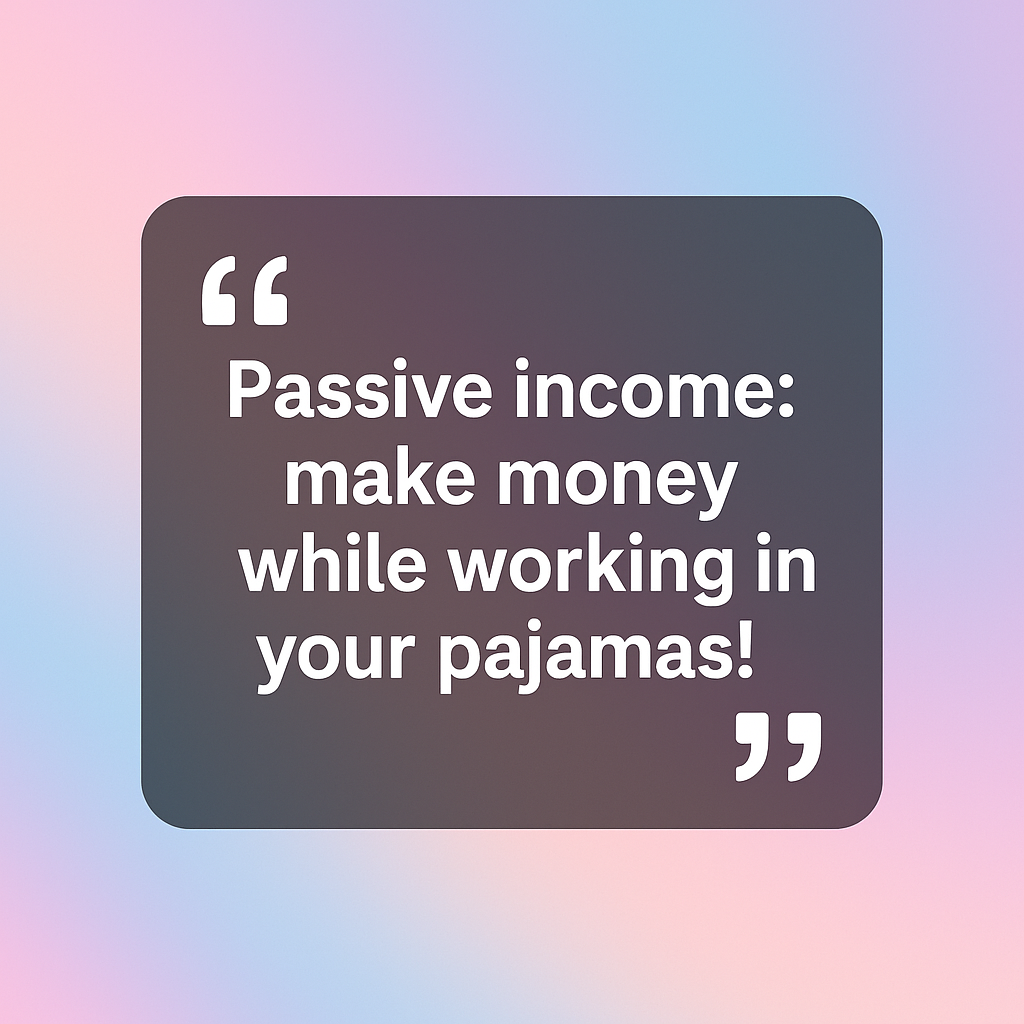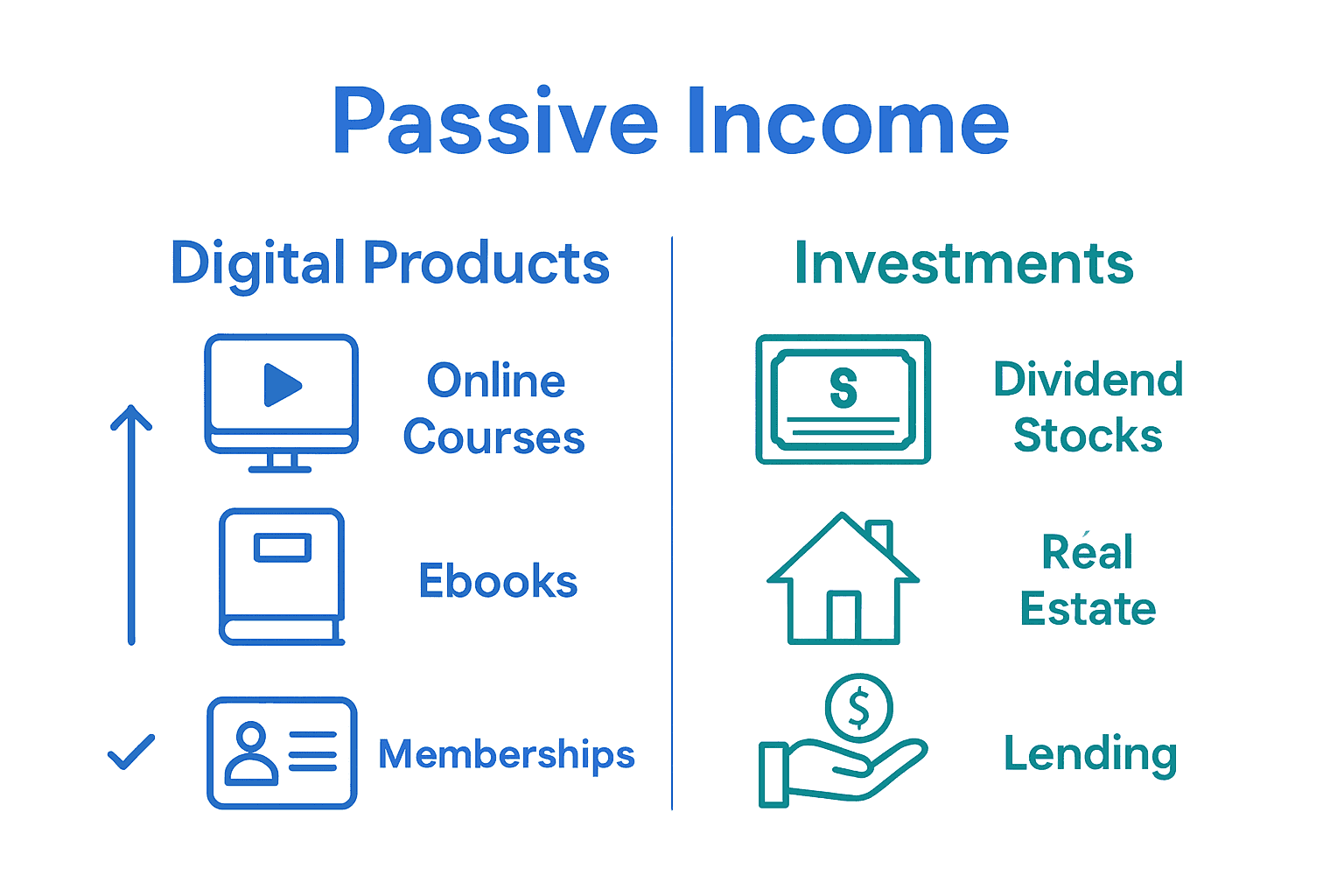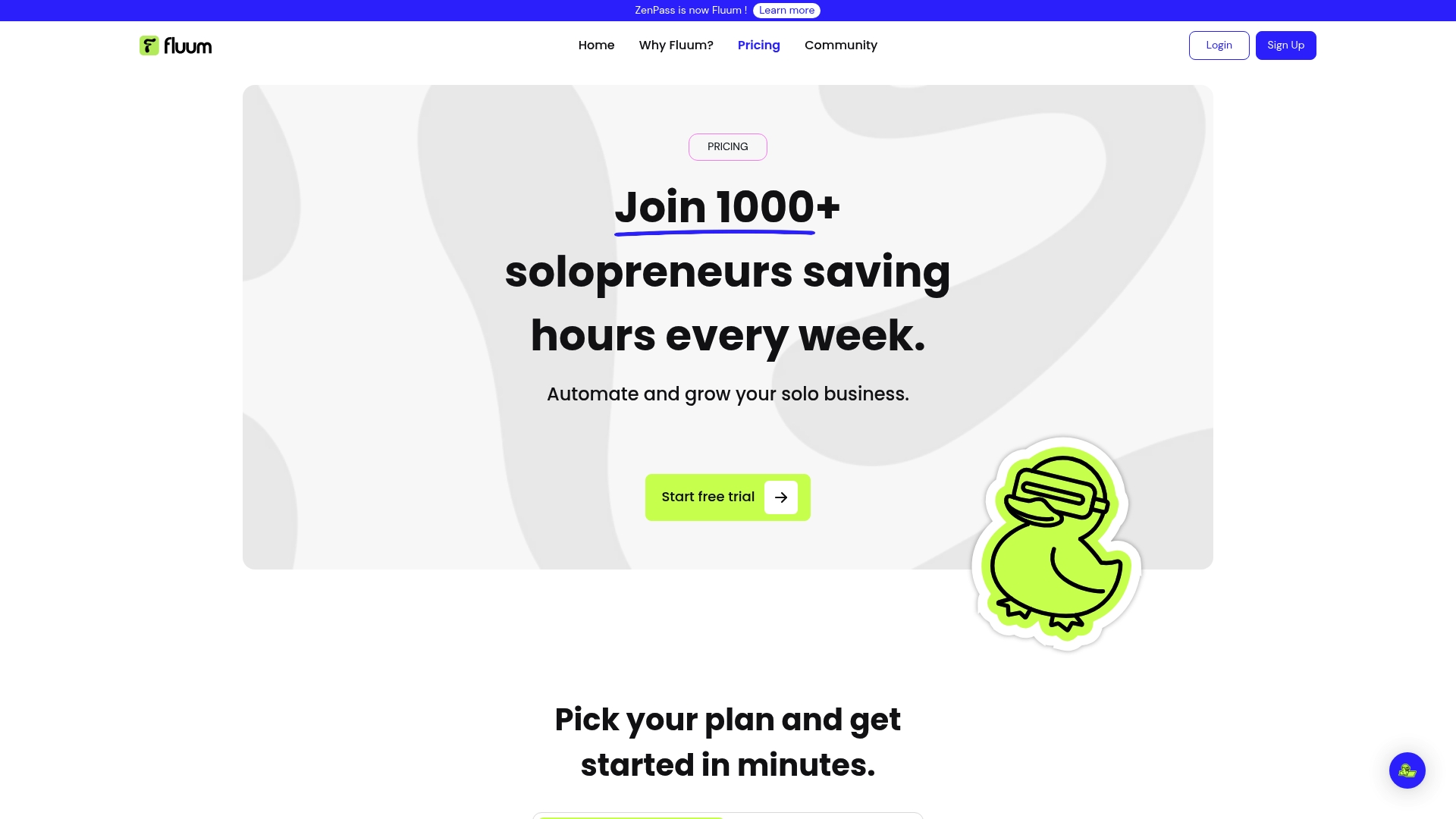
What is passive income? More than 60 percent of solopreneurs dream of earning income passively, yet few truly understand what it takes to build steady automated revenue. Myths about effortless money keep circulating, making it easy to chase false promises instead of lasting results. Learning how passive income really works empowers you to build financial security, avoid costly mistakes, and turn your expertise into ongoing returns that work for you long after the initial effort is complete.
Key Takeaways
| Point | Details |
|---|---|
| Understanding Passive Income | It requires upfront investment and ongoing effort, aiming for long-term wealth rather than quick returns. |
| Diversification is Key | Solopreneurs should develop multiple income streams to enhance financial resilience and mitigate risks. |
| Tax and Legal Awareness | Be mindful of jurisdiction-specific tax implications and compliance requirements related to passive income. |
| Strategic Planning and Optimization | Continuous learning and adaptation are essential for maintaining and improving passive income generation systems. |
Table of Contents
- Defining Passive Income And Common Myths
- Major Types Of Passive Income Streams
- How Passive Income Works For Solopreneurs
- Key Tax And Legal Considerations Worldwide
- Risks, Costs, And Mistakes To Avoid
Defining Passive Income and Common Myths
Passive income represents earnings generated with minimal ongoing effort or direct labor. Passive income is not about getting money for doing nothing, but strategically creating revenue streams that require upfront investment and periodic maintenance. According to research from economic sources, this income typically emerges from investments, digital products, affiliate marketing, or business systems designed to generate continuous returns.
Contrary to popular belief, passive income is not a get-rich-quick scheme. It demands significant initial work, strategic planning, and consistent optimization. While rental properties, dividend stocks, or online courses can generate recurring revenue, solopreneurs must invest substantial time developing systems, creating valuable content, and establishing reliable distribution channels. Learn more about passive income ideas for service providers to understand potential strategies.
Common myths about passive income include:
- Believing it requires zero ongoing effort
- Expecting immediate substantial returns
- Thinking any side project automatically becomes passive
- Assuming complex technical skills are mandatory
Successful passive income generation requires patience, strategic thinking, and willingness to experiment. Solopreneurs should view it as a long-term wealth-building approach rather than an overnight solution. By understanding realistic expectations and developing scalable systems, entrepreneurs can gradually transform active labor into sustainable passive revenue streams.
Major Types of Passive Income Streams
Solopreneurs have multiple avenues for generating passive income, categorized broadly into digital creative products and investment-based streams.

According to research from Shopify, these income sources range from digital creations like online courses and ebooks to investment channels such as dividend stocks and rental properties. The key is selecting streams that align with your skills, resources, and long-term business strategy.
Digital product streams offer significant potential for service providers. These include:
- Online courses teaching specialized skills
- Digital downloads like ebooks, templates, or guides
- Affiliate marketing commissions
- Software products or mobile applications
- Membership platforms with recurring subscriptions
Creating multiple income streams requires strategic planning that balances initial effort with potential long-term returns. Investment-based passive income options like dividend investments, real estate rentals, or peer-to-peer lending can provide more traditional wealth-building opportunities. Each stream demands different levels of upfront investment and ongoing management.

Here’s a quick comparison of popular passive income stream types for solopreneurs:
| Stream Type | Example Channels | Upfront Effort | Ongoing Maintenance |
|---|---|---|---|
| Digital Products | Online courses Ebooks Templates | High (content creation) | Moderate (updates, support) |
| Affiliate Marketing | Product recommendations Links in content | Moderate (setup, niche research) | Low (periodic link checks) |
| Software & Apps | Mobile apps Digital tools | High (development) | Moderate (bug fixes, updates) |
| Memberships | Subscription sites Exclusive content | High (content, systems) | High (fresh content) |
| Investment-Based | Dividend stocks Rental properties | Varies (capital required) | Varies (management, tracking) |
Successful passive income generation isn’t about finding a single perfect solution, but developing a diversified portfolio. Solopreneurs should experiment with multiple streams, continuously learning and optimizing their approach. The most effective passive income strategy combines your existing expertise with scalable, automated revenue channels that generate returns while you focus on core business activities.
How Passive Income Works for Solopreneurs
Passive income for solopreneurs operates through strategic systems that generate recurring revenue with minimal ongoing effort. Automated income streams transform traditional service delivery by creating digital products and scalable business models that continue generating returns after initial creation. According to research from CreatesellBlog, solopreneurs can leverage digital products like online courses, templates, and guides to build predictable revenue channels.
The mechanics of passive income for solo providers typically involve:
- Creating evergreen digital content
- Developing automated marketing funnels
- Implementing recurring subscription models
- Building scalable online delivery systems
- Minimizing direct service time requirements
Understanding the solopreneur business model becomes crucial in designing effective passive income strategies. Successful implementation requires upfront investment in content creation, marketing automation, and systematic product development. Solopreneurs must design products that solve specific client problems while remaining easily consumable and minimally dependent on continuous personal intervention.
The key to sustainable passive income lies in continuous optimization and diversification. By developing multiple digital revenue streams, solopreneurs can create financial resilience, reduce direct labor intensity, and build a more flexible business model. The goal is transforming specialized knowledge into self-sustaining products that generate income independently of constant personal time investment.
Key Tax and Legal Considerations Worldwide
Passive income taxation represents a complex landscape for solopreneurs, with significant variations across different jurisdictions. According to research from Wikipedia, tax treatment of passive income involves nuanced legal classifications that can dramatically impact overall earnings. The fundamental challenge lies in understanding how different countries define and tax income streams generated with minimal direct labor.
Key tax considerations for solopreneurs include:
- Differentiating between active and passive income sources
- Understanding jurisdiction-specific tax reporting requirements
- Tracking income from digital and international platforms
- Managing potential cross-border taxation complexities
- Maintaining accurate financial documentation
Boost your profits by understanding business revenue strategies can help navigate these intricate financial landscapes. Wikipedia highlights that international passive income can trigger double taxation risks, where the same income might be taxed in multiple jurisdictions. Solopreneurs must carefully investigate tax treaties, foreign-source income exemptions, and potential tax credits to minimize their overall tax burden.
Navigating legal and tax considerations requires proactive planning and potentially professional consultation. Successful solopreneurs develop robust systems for tracking international income, understanding local tax regulations, and maintaining compliance across different jurisdictions. The goal is creating a sustainable passive income strategy that maximizes earnings while minimizing legal and financial risks.
Risks, Costs, and Mistakes to Avoid
Passive income streams are not guaranteed money machines and come with significant potential pitfalls that solopreneurs must carefully navigate. The initial investment of time, resources, and potential financial capital can be substantial, with no absolute certainty of returns. Creating sustainable passive income requires strategic planning, continuous learning, and the ability to adapt quickly to changing market dynamics.
Common risks and mistakes solopreneurs encounter include:
- Underestimating the upfront time and financial investment
- Failing to continuously update and maintain digital products
- Overlooking marketing and distribution strategies
- Neglecting legal and tax compliance requirements
- Creating products without clear market demand
- Expecting immediate or guaranteed income
Mastering bookkeeping fundamentals can help mitigate financial risks associated with passive income generation. Successful solopreneurs recognize that passive income is not a hands-off approach but a strategic business model requiring ongoing attention. The most critical mistake is viewing passive income as a quick solution rather than a long-term wealth-building strategy that demands consistent effort, market research, and personal skill development.
To minimize risks, solopreneurs should diversify their passive income streams, invest in continuous learning, and maintain realistic expectations. This means creating multiple digital products, staying updated with market trends, and being prepared to pivot or improve offerings based on customer feedback. The key is building resilient, adaptable income systems that can weather market fluctuations and changing consumer preferences.
Ready to Build Real Passive Income With Less Stress?
Many solopreneurs struggle with turning their expertise into genuine passive income. You have learned from this guide that success requires more than just great ideas. It takes organized systems, smart automation, and business models that run smoothly even when you are not working. If you are frustrated by tech roadblocks or tired of risky trial and error, you do not have to stay stuck in the cycle of overwhelm or slow progress.

Fluum.ai is your shortcut to simple, scalable passive income. Use our all-in-one platform to create automated sales funnels, launch digital products, and manage clients in one place. No complicated setups. No need for web development skills. Get ready to increase your revenue while freeing up valuable time. See our affordable plans and unlock the tools designed to turn your service business into a self-sustaining revenue machine. Take action now and move your first passive income stream from an idea into reality.
Frequently Asked Questions
What is passive income?
Passive income refers to earnings generated with minimal ongoing effort or direct labor, typically from investments, digital products, or automated business systems.
How do digital products contribute to passive income for solopreneurs?
Digital products like online courses, ebooks, or templates can create automated revenue streams that continue to generate income after their initial creation.
What are the common misconceptions about passive income?
Common misconceptions include the belief that passive income requires no ongoing effort, that it leads to immediate substantial returns, and that any side project will automatically become passive.
How can solopreneurs manage tax considerations related to passive income?
Solopreneurs should differentiate between active and passive income sources, track international income, and understand jurisdiction-specific tax reporting to manage their passive income tax obligations efficiently.
Recommended
- Fluum | Effective Stress Management Techniques for Busy Professionals
- Fluum | How to Onboard Clients Effectively for Lasting Success
- Fluum | Master Managing Multiple Projects for Success
- Fluum | Build Your Brand with a Branding Builder in 2025
- Fluum | 7 Customer Retention Examples to Boost Your Business



